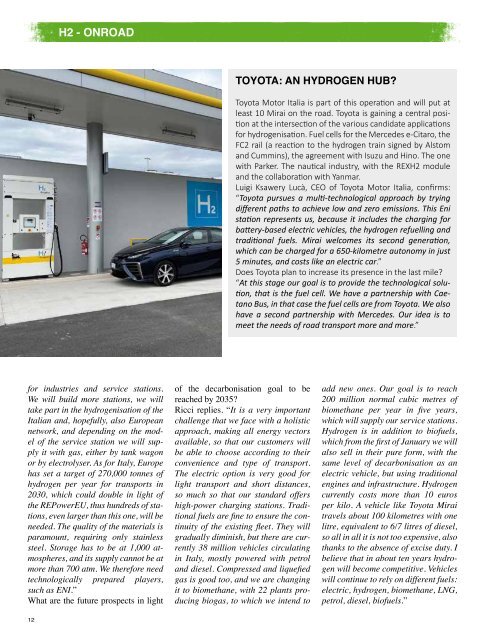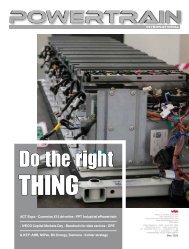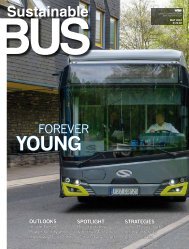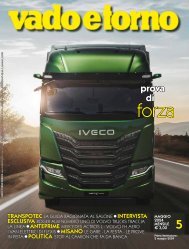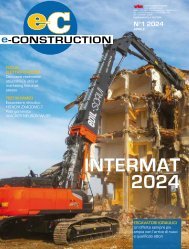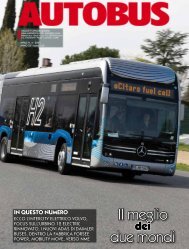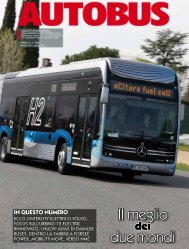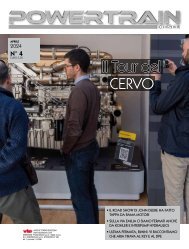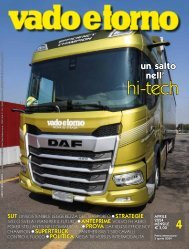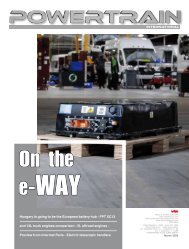Powertrain | Diesel International 2022-11
DIESEL OF THE YEAR KOHLER KSD: Easy to maintain ONROAD IAA HANOVER: Hydrogen ICE: Cummins, FPT Industrial, Weichai POWER GENERATION ISOTTA FRASCHINI: 12V170 G and IFuture CUMMINS: Power Integration Center, Minnesota ROLLS-ROYCE POWER SYSTEMS: PG Symposium, Friedrichshafen MITSUBISHI: In Africa, with Linz Electric PREVIEWS BAUMA MUNICH: Hatz, Kohler, Kubota, Liebherr, Yanmar, Volvo EVENTS IVECO GROUP: Beyond... the power of sharing MARINE CANNES YACHTING FESTIVAL: Electric, hybrid and methanol SMM HAMBURG: ABB, Baudouin, FPT Industrial, MAN, mtu, Volvo BATTERY MANAGEMENT BORGWARNER: For electric cars MARELLI: Wireless Distributed BMS COLUMNS Editorial; Newsroom; Automotive; Techno (Siemens)
DIESEL OF THE YEAR
KOHLER KSD: Easy to maintain
ONROAD
IAA HANOVER: Hydrogen ICE: Cummins, FPT Industrial, Weichai
POWER GENERATION
ISOTTA FRASCHINI: 12V170 G and IFuture
CUMMINS: Power Integration Center, Minnesota
ROLLS-ROYCE POWER SYSTEMS: PG Symposium, Friedrichshafen
MITSUBISHI: In Africa, with Linz Electric
PREVIEWS
BAUMA MUNICH: Hatz, Kohler, Kubota, Liebherr, Yanmar, Volvo
EVENTS
IVECO GROUP: Beyond... the power of sharing
MARINE
CANNES YACHTING FESTIVAL: Electric, hybrid and methanol
SMM HAMBURG: ABB, Baudouin, FPT Industrial, MAN, mtu, Volvo
BATTERY MANAGEMENT
BORGWARNER: For electric cars
MARELLI: Wireless Distributed BMS
COLUMNS
Editorial; Newsroom; Automotive; Techno (Siemens)
Create successful ePaper yourself
Turn your PDF publications into a flip-book with our unique Google optimized e-Paper software.
H2 - ONROAD<br />
#ENI #ITALY #TOYOTA<br />
TOYOTA: AN HYDROGEN HUB?<br />
Toyota Motor Italia is part of this operation and will put at<br />
least 10 Mirai on the road. Toyota is gaining a central position<br />
at the intersection of the various candidate applications<br />
for hydrogenisation. Fuel cells for the Mercedes e-Citaro, the<br />
FC2 rail (a reaction to the hydrogen train signed by Alstom<br />
and Cummins), the agreement with Isuzu and Hino. The one<br />
with Parker. The nautical industry, with the REXH2 module<br />
and the collaboration with Yanmar.<br />
Luigi Ksawery Lucà, CEO of Toyota Motor Italia, confirms:<br />
“Toyota pursues a multi-technological approach by trying<br />
different paths to achieve low and zero emissions. This Eni<br />
station represents us, because it includes the charging for<br />
battery-based electric vehicles, the hydrogen refuelling and<br />
traditional fuels. Mirai welcomes its second generation,<br />
which can be charged for a 650-kilometre autonomy in just<br />
5 minutes, and costs like an electric car.”<br />
Does Toyota plan to increase its presence in the last mile?<br />
“At this stage our goal is to provide the technological solution,<br />
that is the fuel cell. We have a partnership with Caetano<br />
Bus, in that case the fuel cells are from Toyota. We also<br />
have a second partnership with Mercedes. Our idea is to<br />
meet the needs of road transport more and more.”<br />
3<br />
2<br />
1<br />
Ready to Go!<br />
Kubota Micro Hybrid Engine<br />
Visit us: A4.327<br />
for industries and service stations.<br />
We will build more stations, we will<br />
take part in the hydrogenisation of the<br />
Italian and, hopefully, also European<br />
network, and depending on the model<br />
of the service station we will supply<br />
it with gas, either by tank wagon<br />
or by electrolyser. As for Italy, Europe<br />
has set a target of 270,000 tonnes of<br />
hydrogen per year for transports in<br />
2030, which could double in light of<br />
the REPowerEU, thus hundreds of stations,<br />
even larger than this one, will be<br />
needed. The quality of the materials is<br />
paramount, requiring only stainless<br />
steel. Storage has to be at 1,000 atmospheres,<br />
and its supply cannot be at<br />
more than 700 atm. We therefore need<br />
technologically prepared players,<br />
such as ENI.”<br />
What are the future prospects in light<br />
of the decarbonisation goal to be<br />
reached by 2035?<br />
Ricci replies. “It is a very important<br />
challenge that we face with a holistic<br />
approach, making all energy vectors<br />
available, so that our customers will<br />
be able to choose according to their<br />
convenience and type of transport.<br />
The electric option is very good for<br />
light transport and short distances,<br />
so much so that our standard offers<br />
high-power charging stations. Traditional<br />
fuels are fine to ensure the continuity<br />
of the existing fleet. They will<br />
gradually diminish, but there are currently<br />
38 million vehicles circulating<br />
in Italy, mostly powered with petrol<br />
and diesel. Compressed and liquefied<br />
gas is good too, and we are changing<br />
it to biomethane, with 22 plants producing<br />
biogas, to which we intend to<br />
add new ones. Our goal is to reach<br />
200 million normal cubic metres of<br />
biomethane per year in five years,<br />
which will supply our service stations.<br />
Hydrogen is in addition to biofuels,<br />
which from the first of January we will<br />
also sell in their pure form, with the<br />
same level of decarbonisation as an<br />
electric vehicle, but using traditional<br />
engines and infrastructure. Hydrogen<br />
currently costs more than 10 euros<br />
per kilo. A vehicle like Toyota Mirai<br />
travels about 100 kilometres with one<br />
litre, equivalent to 6/7 litres of diesel,<br />
so all in all it is not too expensive, also<br />
thanks to the absence of excise duty. I<br />
believe that in about ten years hydrogen<br />
will become competitive. Vehicles<br />
will continue to rely on different fuels:<br />
electric, hydrogen, biomethane, LNG,<br />
petrol, diesel, biofuels.”<br />
Economical solution for short-term high loads<br />
The Kubota Micro Hybrid engine is equipped with a 48-volt motor generator and provides up to 10 kW of additional<br />
electrical power to match short-term infrequent high loads. This allows customers to select an efficient engine with<br />
an output power matching the lower and medium load demands frequently used. Applications already equipped<br />
with a compatible Kubota engine can be converted retrospectively.<br />
• Simple, easy to install system<br />
• High torque, direct response<br />
• Lower operating costs<br />
global.engine.kubota.co.jp/en/technology/microhybrid<br />
12


